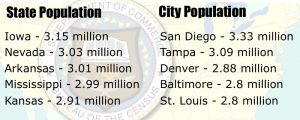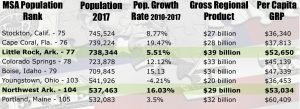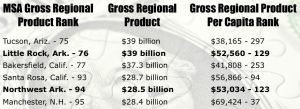Dare to compare: finding our ‘peers’
by June 9, 2019 9:52 am 761 views

Editor’s note: Jamie Gates, executive vice president of the Conway Development Corp., is a new monthly Talk Business & Politics contributor with his column, “Data Points.” Gates will explore data related to Arkansas’ population, economy and demographic trends. You can watch a video conversation of this topic at the end of this post.
Welcome to the first “Data Points” article. The goal of the series is to collect, interpret, and share data that will drive conversation. Sometimes we will come to our own conclusions. Sometimes we will just “put it out there” and see where the conversation (online and off) leads. But we will always start by setting context with amazing (and usually publicly available) economic and demographic data.
This first article will focus on establishing just where Arkansas and its two largest Metropolitan Statistical Areas (MSAs) stack up nationally. When comparing places and their economies, the MSA is the most relevant measure. Municipal boundaries are frequently complicated by history or statute and aren’t especially useful when ranking.
You can see that Arkansas’s closest population peers at the state level are Nevada and Mississippi. And if Arkansas were a major city it would sit somewhere between Tampa and Denver. So when we make decisions as a state, we need to understand that Arkansas would only be the 18th largest MSA in the country. Yet we’re spread out over 10 to 20 times the land mass. This exercise may seem a little foolish, but we frequently talk in terms of “competing” with other states. Whether we’re discussing policy or access to markets and talent, scale matters.
Next, we look at our two largest MSAs: the Little Rock/North Little Rock/Conway MSA and the Fayetteville/Springdale/Rogers MSA. (I’ll refer to them simply as the “Little Rock” or “central Arkansas” MSA and the “northwest Arkansas” MSA for the remainder of the article).
As Northwest Arkansas has grown in size and influence, it’s become fashionable for Arkansans — especially native Arkansans — to fixate on just how different these two places are. Out of the United States’ 383 MSAs Little Rock and Northwest Arkansas rank as the 77th and 104th largest (The Fort Smith and Jonesboro MSAs rank 170th and 305th respectively).
Beyond static population, when trying to find a relevant peer one of the key factors is rate of growth. Simply put, places (almost regardless of size) that are growing share a lot of traits and dynamics. The same could be said for those that are shrinking.
While the Youngstown, OH MSA has almost the exact same population as Northwest Arkansas, it will look and feel like a dramatically different place because their economy is a full one-third smaller and their population is in rapid decline.
No one familiar with Arkansas would be surprised to see the incredible rate of growth in Northwest Arkansas’s population. It was the 14th fastest growing MSA from 2010-2017, adding almost 75,000 people. However, even though the Little Rock MSA grew at a much slower rate, it still added almost 40,000 people over the same time period. Again, scale matters. If each area maintains the same growth rate, the Little Rock MSA will remain the state’s largest for another 22 years. At that time each MSA would have approximately 875,000 residents.
Beyond population and growth rate, the final metric that helps us find our true peers is gross regional product (GRP). It’s the local equivalent of gross domestic product and measures the goods and services produced in an area. The size and regional nature of the local economy can make a place feel smaller or larger than its population. Also relevant is the per capita gross regional product. Places with a similar GRP will frequently have similar housing costs and retail options.
It may surprise many that the GRP per capita in the Little Rock MSA and Northwest Arkansas MSA are within 1% of each other. Remember that there are approximately 200,000 more residents in the Little Rock MSA. That’s why you see leading brands like Apple, Trader Joes, and more with only one location and only in central Arkansas (Tampa also only has one Apple store by the way). Again, with retail—scale matters.
Northwest Arkansas’s rate of economic growth is as impressive as their population growth. If both Northwest Arkansas and central Arkansas maintain their historic rates of GRP growth, they will be equal in size in 15 years.
When you take all of the MSAs in the country and rank them by population, rate of growth, GRP, and GRP per capita you do start to get a clearer picture of how Arkansas and our two largest metros stack up. For the Little Rock MSA, there are places like Knoxville, TN and Greenville, SC that match closely. For Northwest Arkansas, you see places like Provo and Ogden, UT and even Charleston, SC that have meaningful similarities.
However, when you look up and down the list of all 383 MSAs, it’s possible that there are no two that could learn more from each other than central Arkansas and Northwest Arkansas — which might surprise us native Arkansans who know “how different” they are.
What do you think? What places from around the country remind you of somewhere in Arkansas? Where can the economies of our state look for ideas and direction?



